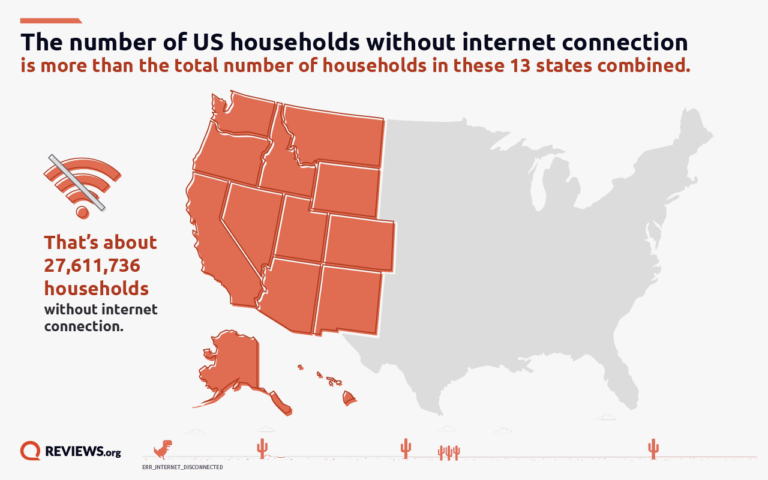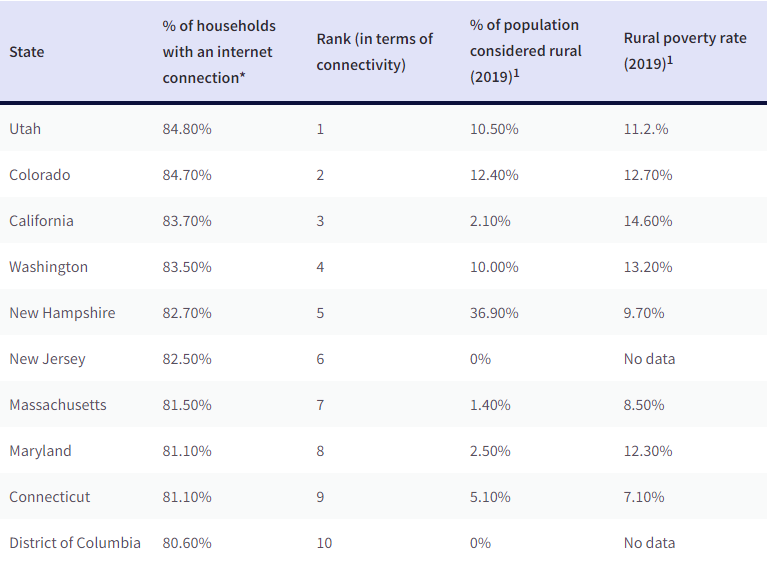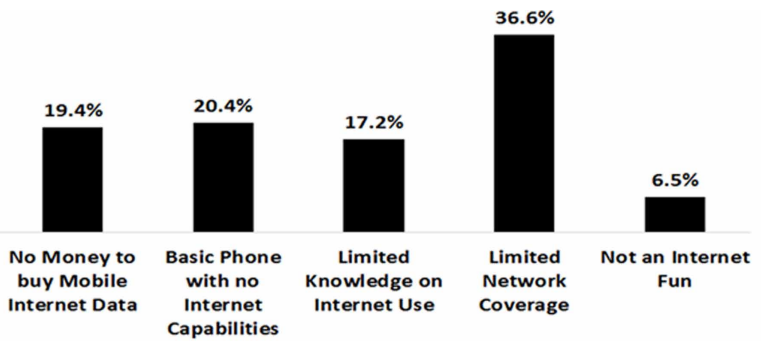Introduction
The purpose of this report is to provide recommendations for which solution to choose to address the problem of connecting rural villages and remote locations to the Internet. These locations will be identified based on the performance of each individual solution given three criteria: Internet reliability, expenditures, and project speed. Depending on the outcomes of the report, one of the options will be selected as preferable.
Problem Background
Rural villages in the US are suffering from poor, unstable, or absent Internet connection. Roughly 25% of all households does not have internet, and 250,000 more have to rely on outdated and unreliable dial-up (McNally, 2021). In Figure 1, the ratio of US households with and without Internet access is presented (McNally, 2021). Having Internet is important for engaging in business practices, education, socializing, and entertainment (Furuholt & Sæbø, 2018). In Table 1, the US ten most connected states are shown (McNally, 2021). Therefore, providing a connection to Internet in these areas is vital for improving the lives and prospects of communities.


Potential Solutions
Some of the potential solutions to improve local Internet access include satellite, mobile, and fiber-cable connection. In Figure 2, Eilu (2018) presents the main factors limiting access to the global network, and these aspects should be taken into account. In addition, to compare the solutions, the criteria of reliability, expenditures, and project speed will be utilized. Satellite Internet is available from any part of the US. However, it is known to require specialized equipment and is expensive. Fiber-cable connection is the fastest and most reliable but requires physical connection by cable. 4G/5G Internet relies on mobile connectivity to transfer data; however, the technology us limited by the location of the nearest transmission towers.

Evaluative Criteria
The proposed evaluative criteria are as follows:
- Internet reliability: The connection has to be stable, sufficiently fast, and be able to endure various issues that might affect its performance;
- Expenditures: These include the costs of providing connection to a remote location as well as service and maintenance;
- Project speed: This parameter stands for how fast and easy could any specific method be utilized to establish connection with the target area.
Satellite Connection
Satellite connection is not the most reliable when it comes to delivering results, as it has several critical points of failure. If the satellite dish has issues, there will be no Internet. If the satellite signal has trouble going through weather, it will be slow (Eilu, 2018). Finally, the provider on the ground may have issues when compromising the whole system. Satellite dishes are expensive, as well as their maintenance, ranging between 30$ to 500$ a month for a limited amount of gigabytes of data per month (Kirkpatrick, 2018). It is, however easy to set to work, as the installation of the dish takes between 2-3 hours.
SoluFiber-Cable Connection
Fiber-cable connection has high reliability, offering both the fastest connection and a relative immunity to the weather and the elements. Internet cables are typically buried underground, immune to wind, snow, and frost (Kirkpatrick, 2018). Reaching a rural village with a cable line is expensive, however, especially considering the connection having to go underground. Once it is done, however, services range between 30$-50$ a month for an unlimited amount of data (Kirkpatrick, 2018). Project speeds are typically slow due to all of the work necessary to bring a fiber-cable connection to a rural area.
4G-5G Internet
4G-5G Internet is faster than dial-up, but not the fastest, with speeds comparable to satellite. It suffers from the same weaknesses – anything that can block mobile connection, including weather, geography, and other factors, can interfere with 4G-5G reliability. Its costs around 50-70$ per month, with no data cap (Kirkpatrick, 2018). It is easy to install, provided a tower is in range. If a rural area is outside of coverage, it requires a serious investment to build a mobile network and use it for 4G-5G connectivity.
Comparison of Results
The comparative results for all three prospective solutions are summarized in this Table 2.
Table 2. Solutions comparison.
Based on the comparison, fiber-cable offers the most reliable connection, with costs being low or high depending on whether the line reaches the settlement or not. Mobile Internet is the easiest to connect to, with moderate costs and subpar reliability. Satellite offers a reasonably reliable connection and good installation speed; nevertheless, price installation is high, which may be a deterrent to introducing this type of connection.
Conclusions and Recommendations
Based on the comparison, fiber-cable can be ruled out as a solution for rural communities, at least in the short-term perspective. Satellite is a quick solution, but expenditures prove to be a significant barrier for most villages. 4G-5G connection, despite its reliability being on the low end of moderate, is easy to reach and offers unlimited connection at an acceptable price. Therefore, the third solution is the most viable for rural communities in short-to-midterm perspectives.
References
Eilu, E. (2018). An assessment of mobile internet usage in a rural setting of a developing country. International Journal of Mobile Computing and Multimedia Communications (IJMCMC), 9(2), 47-59.
Furuholt, B., & Sæbø, Ø. (2018). The role telecentres play in providing e‐government services in rural areas: A longitudinal study of Internet access and e‐government services in Tanzania. The Electronic Journal of Information Systems in Developing Countries, 84(1), e12006.
McNally, C. (2021). Nearly 1 in 4 households don’t have Internet – and a quarter million still use dial-up. Reviews. Web.
Kirkpatrick, K. (2018). Bringing the Internet to the (developing) world. Communications of the ACM, 61(7), 20-21.
Glossary of Terms
- Fiber-cable – a type of cable in which the main element is a transparent glass fiber that transmits information through a light signal over long distances.
- Mobile connection – a type of mobile radio in which the coverage area is divided into cells defined by the coverage areas of individual base stations.
- Satellite Internet – a way to connect to the global network via satellite communications through special devices that transmit a signal.